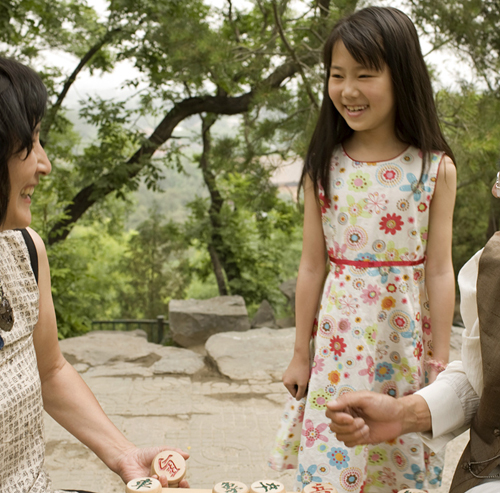Chinese With
a history of revolution, migration, organized crime and incessant
trading, the witty and streetwise Cantonese are the New Yorkers of
China, and make up the majority of Hong Kong’s population. There are
also large communities of Shanghainese, Hakka (Kejia) and Chiu Chow
(Chaozhou) people.

Chinese fisherman

Chinese chequers
British Colonial
power may have vanished, but a large British population remains,
including a small but influential community of native-born. Influences
are everywhere, from street names (“Lambeth Walk”, “Rutland Quadrant”)
to school blazers. Eurasian The
traditional role of this community of mixed European and Asian descent –
as cultural and commercial brokers between East and West – remains
undiminished. If anyone can claim to truly embody Hong Kong’s intriguing
duality, it is this young, wealthy and internationally-minded
community. Portuguese In
the Pearl River Delta since the arrival of traders in the 16th century,
the Portuguese have inter-married extensively with the Cantonese. Aside
from a clutch of surnames (da Silva, Sequeira, Remedios), a lasting
influence has been the fostering of an addiction to egg tarts and
pastries. Indian The
history of Hong Kong’s substantial Indian population (there are Hindus,
Muslims and Sikhs) dates from the arrival of the British in 1841. Like
the Eurasians, young Indians have rejected purely Western or Asian
notions of identity, pioneering instead a synthesis of both. Jewish Hong
Kong has one of the oldest Jewish communities in east Asia, producing
patrician business dynasties (the Sassoons, the Kadoories) and one of
the most colourful colonial governors (Sir Matthew Nathan, 1903–1906). Russian A
few now elderly descendants are all that is left of the former émigré
community. Hong Kong’s White Russians were once numerous, and you still
find borsch on the menu of every takeaway and coffee shop. Overseas Chinese The
surging growth in British, American- and Canadian-born Chinese
(nicknamed BBCs, ABCs and CBCs respectively) has been a characteristic
of the last two decades, as the well-educated children of emigrants
return in search of roots and white-collar work. Filipino Most
members of the largest ethnic minority stoically perform the low-paid
occupations that Hong Kongers shun, working as domestic servants,
drivers, waiting staff and bar room musicians, and remitting most of
their income back home to the Philippines. Filipinas promenade in their
thousands every Sunday at Statue Square . Australian Working
mostly in business and the media, the size of this community is
reflected in the fact that it boasts the largest Australian Chamber of
Commerce outside of Australia, and one of only two Australian
International Schools in the world.
Top 10 Patois and Lingo in Hong Kong
Chinglish The local patois, which freely uses sinicized English words like sahmunjee (sandwich), bahsee (bus), lumbah (number) and kayleem (cream). Portuguese Many borrowings, including praya (waterfront road), joss (a corruption of deus, or god) and amah (maid). Anglo-Indian/Persian Several words, including shroff (cashier), nullah (channel or watercourse) and tiffin (lunch). Mo Lei Tau The impenetrable slang used by young Cantonese. Based on surreal and seemingly nonsensical phrasing. “Jaihng” All-purpose slang term meaning “cool”, “excellent”. (As used in the Hollywood film Wayne’s World.) “Yau Mehr Liu?” Translates roughly as “What’s your talent?” but used as a streetwise greeting; a bit like “what’s up?” or “wassup?” “Godown” Hong Kong English for warehouse or storage facility; a contraction of “go put your load down”. “Whiskey Tangos” Hong Kong police slang for “white trash”. “Aiyah!” The universal exclamation of disappointment, surprise or regret. “Ah-” Prefix added to names when denoting affection, as in “Ah-Timothy”, “Ah-Belinda”.
|